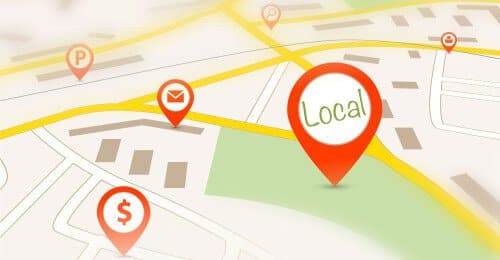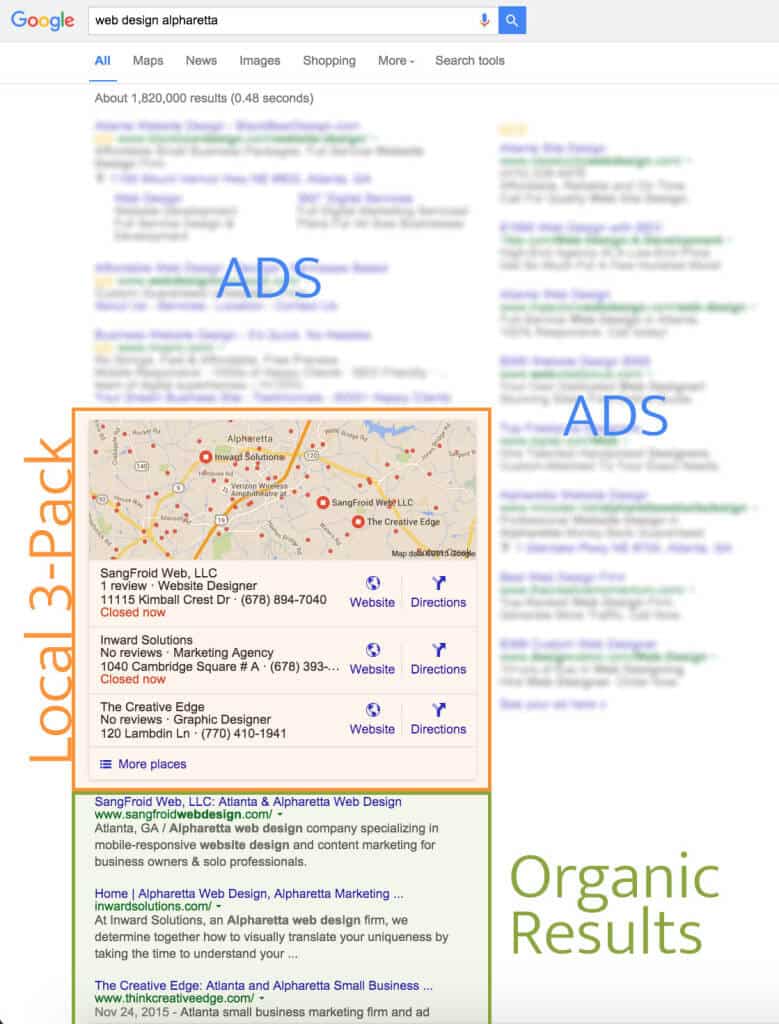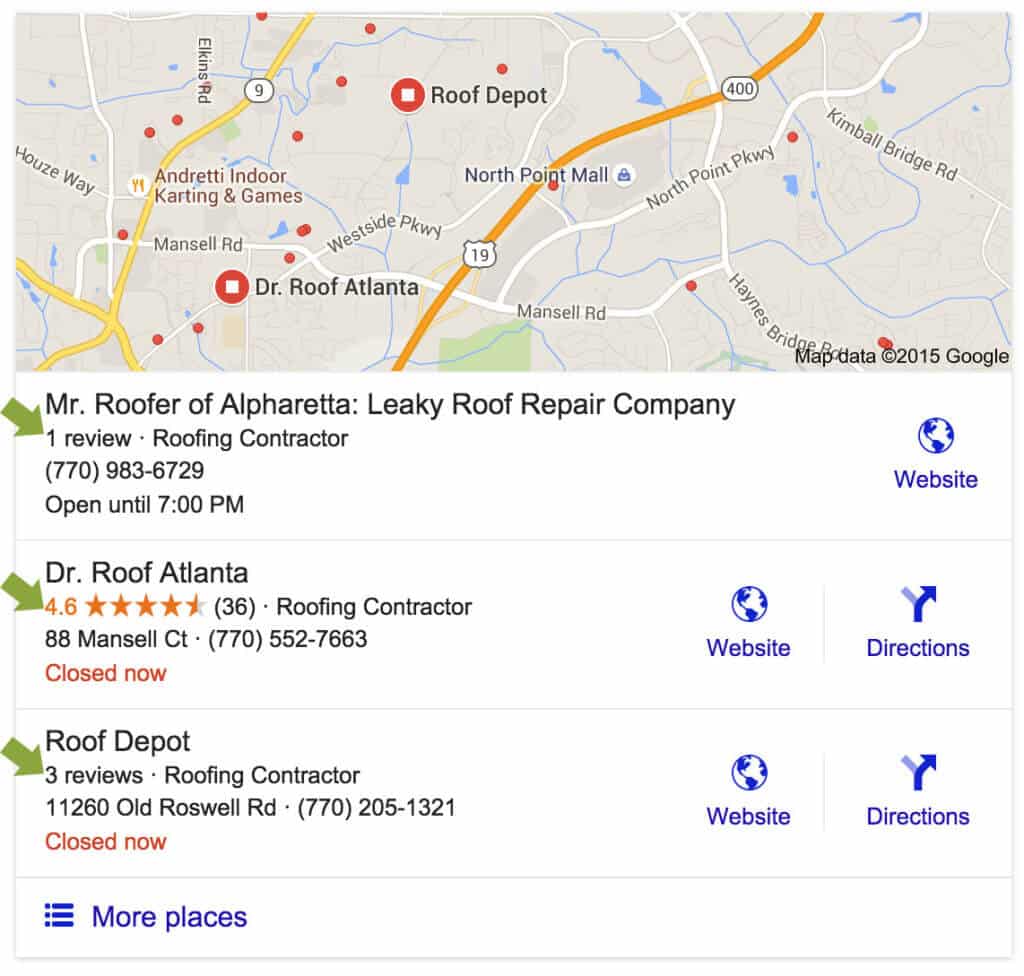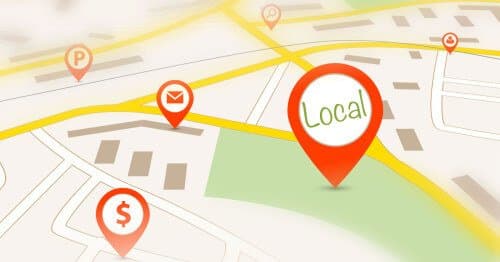
If you have a local storefront or service-area, or your business is geographically-based in some way, then you should be investing in Local SEO.
In this post, we'll cover the basics and give you some important next-steps you should do.
What is Local SEO?
Local SEO is the set of practices put in place to help your website rank well in local search results (The focus is mainly on Google). Local search results are the results that search engines return based on the searcher's location (or their intended location)....they are a little different than regular organic results.
So, for instance, if you type 'restaurants' into Google right now, you will get a list of restaurants in your area of town....the restaurants most relevant to you geographically.
Organic Results vs. The Local 3-Pack
The listings at the top of the results page of a local search are shown in a special list of local businesses accompanied by a map. These listings are called the Local 3-Pack (see example below).
Local SEO focuses on getting your Google My Business listing into these local listings...ideally in the 3-Pack...for terms related to your business and services.

How is Local SEO different from 'Regular' SEO?
'Regular' or traditional national SEO centers around getting your website to the top of the organic listings, which show up underneath the Local 3-Pack. Your website is the center of focus for 'regular' SEO, while in Local SEO, your Google My Business listing is much more of a major consideration.
You'll get the best results when using both Organic SEO and Local SEO techniques.
Did You Know?
Google web searches containing the expression "near me" have doubled since March 2017. (According to Google Trends data from March 2019)
Get Listed on Google My Business
As you can see in the image, the 3-Pack only shows businesses that are listed with Google My Business, so before doing anything else, make sure your business is registered and you have claimed a custom URL. If your business is already listed with Google, make sure you have claimed the listing.
We won't go into the details of how to create or claim a Google My Business profile in this post, but there are many posts that cover it like this one.
Be aware that Google has guidelines on how to represent your business on Google.
Local SEO Doesn't Work in a Vacuum
Overwhelming evidence exists that shows Local SEO results are correlated with Organic SEO results. The Local SEO Guide Search Ranking Factors confirms that one of the strongest indicators of success with Local SEO is success with Organic SEO.
Basically, if you rank 1-10 in organic search results for a specific phrase, you are much more likely to rank 1-10 in Google My Business results as well. Keep this in mind as you build your local presence.
Take These Next Steps to Build Your Local Presence
Now, assuming that Google knows your business exists, start with these basic Local SEO strategies to build your local presence.
1. Add Citations for Your Business
Citations are mentions of your business name and address on other webpages. A citation is important even when the source doesn't link back to your site.
Examples of citation sources are business directories (like Yelp or YP.com) where your business is listed. Citations can be found on local business organization websites such as Chamber of Commerce sites, or national business associations to which you or your business belong such as accreditation organizations or trade associations.
Citations are an important part of the local ranking algorithms for both Google and Bing.
You can accumulate citations by listing your business on reputable directories and search engines. You can do this yourself over time, use a paid service to help you manage your business citations, or hire a consultant to help you complete a citation project.
If you are going to work on getting citations yourself, you can use these tools to get started:
WhiteSpark List of the Top Citation Sources - This is a comprehensive, qualified list of the top citation sources listed by country - including the top 50 citation sources for the U.S. If you're not into DIY you can try the WhiteSpark Local Citation Finder.
Moz Local "Check My Listing" Tool - This is a free tool that will help you quickly identify missing, inaccurate and duplicate citation information for some of the major citation sources.
Paid Services for Creating and Managing Citations
Adding and Managing your listings in directories can quickly become tedious even with all the free resources available. There are paid services you can use to help you manage the process.
Automation-Based Services
Automated services will help you find and organize the citation building process. You will be managing the work.
- Moz Local
- Yext ( I've read a case study that make me wary of recommending Yext -- check here. ) Although Yext says in this article that only the 'enhanced content' is removed when you cancel the Yext Power Listing service. There are some listings that can ONLY be gained via Yext because of their exclusive partnership, but I find the high monthly price of Yext is not justified for what you are actually getting.
Note that these solutions may not be a good value for a small business. You have to pay annually or monthly for the service, and when you cancel, you lose some of the progress you made on your listings. For businesses with multiple locations and profiles to manage, the annual fee may be worth the headache of managing multiple locations.
Human-Based Services
These citation services are completed by hand by a person. We work with both Bright Local and White Spark for major citation projects.
- Bright Local Citation Builder (This is our affiliate link)
- WhiteSpark
Quality and authority of citations is the 4th most important local ranking factor according to Local Search Ranking Factors published annually by Moz.
2. Clearly Communicate Your City/State Location on Your Website
This seems like an obvious one, but make sure your City/State location appears on every page of your website. The footer of the website is an ideal location to do this. Combine this item with #4 below by adding a widget containing your business address and contact information (marked up with Structured Data) to your footer and you will be all set.
The goal is to communicate clearly to search engines where you are located, so be sure to mention your City and State location in the content on your site where it makes sense.
Definitely do NOT stuff your content full of City/State mentions, just mention it when it makes sense.
Some other out of the box ways that may help signal your Location from your website:
Geo-Coding Images: If you geocode your images, it helps give search engines high confidence that your content should be associated with a particular geographic location.
3. Get Reviews
Building a foundation of honest and positive reviews (from real customers) for your business on your Google My Business Page (and other review sites like Yelp) is one of the most powerful investments you can make in Local SEO.
Reviews Appeal to Potential Customers
According to BrightLocal's 2018 Annual Survey of Local Consumers, 86% of consumers read reviews for local businesses (including 95% of people aged 18-34) That is essentially everyone!
Search Engines Consider Reviews, Too!
Customers aren't the only ones considering reviews. Search engines are using reviews to rank your website in Local Search Engine Results. "Review Signals" account for a decent percentage of Moz's Annual Survey of Local Search Ranking Factors.
2017 Update: Google 3-Pack listings now show stars starting with just 1 review instead of 5.
Prior to February 2017, a minimum of 5 reviews on your Google My Business page were required for your listing to display with the number of stars instead of a link that says "1 Review" or "3 Reviews".
Google also now calculates ratings using a straight average instead of a Bayesian average. This means that a company with a single 5 star review can have a higher rank than a company with 9 5-Star reviews and a single 4-Star review. However, a straight average is better understood by both consumers and business owners.

4. Add Your Business Name, Address and Phone (NAP) to Your Website Using Structured Data
First, let's explain what Structured Data is...
Adhere Creative describes structured data and its relationship to SEO perfectly:
“Structured data allows search engines to not only crawl your site, but to truly understand it. Yes, even search engines can have a tough time deciphering web page content. Some elements that seem perfectly obvious to us humans are meaningless to web crawlers.
Structured data is on-page markup that enables search engines to better understand the information currently on your business’s web page, and then use this information to improve your business’s search results listing. For example, structured data makes it easier for web crawlers to determine company basics, such as NAP (name, address, place) data, as well as more complex information such articles, events, products, recipes, etc. on your website.”
Structured Data May be the Future of Search Engine Optimization
Google has repeatedly said that adding structured data markup to your page won’t directly lead to your page ranking better in Google results, but that may change in the future.
[ Related: Read How Structured Data Helps in Search Rankings ]
Google’s John Mueller recently mentioned that Google may add structured data markup as a ranking factor. So, exploring ways to incorporate structured data to help search engines understand your site better is probably in order.
Add NAP Information in a Text Widget
For now, start with the very basics by getting just your NAP information marked up using Structured Data and added to every page of your website.
The simplest implementation of this on most WordPress sites is to use a text widget with the structured data code in the footer of your site.
To generate the code that should go in the text widget, you can use the Schema.org Microgenerator tool.
We also use the WP SEO Structured Data Schema plugin to create structured data on websites. This plugin works well and allows you to add more than just NAP information. [Watch a video on how to add basic structured data to your site with a plugin »]
If dealing with code is not your thing, no worries...reach out to us and see how we can help. If you are ready to dig deep into the world of structured data, try following the directions in this White Spark post to make your structured data even better.
To be sure that your schema is correct, you can check it using the Google Structured Data Testing Tool.
Get Started Sooner Rather Than Later
While there are even more advanced Local SEO strategies you can use, build a solid foundation by addressing the items in this post first. Starting now will give your business a huge advantage over most other small businesses.
Have questions or comments?...Let me know in the comments below.



